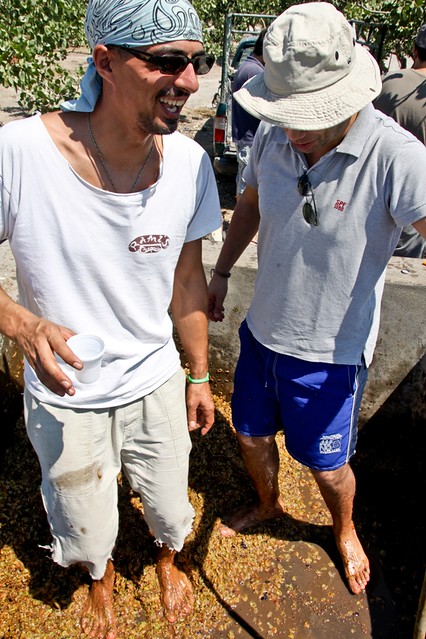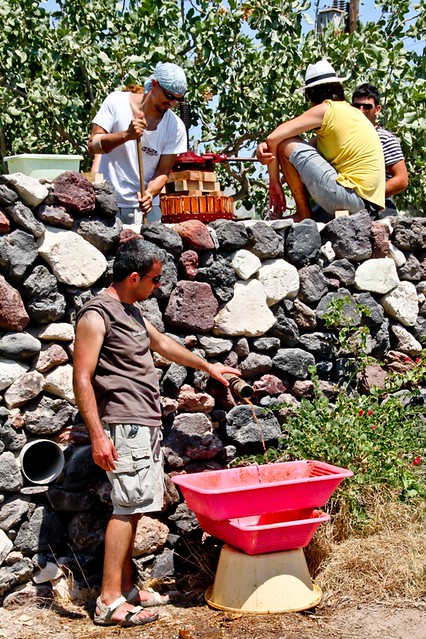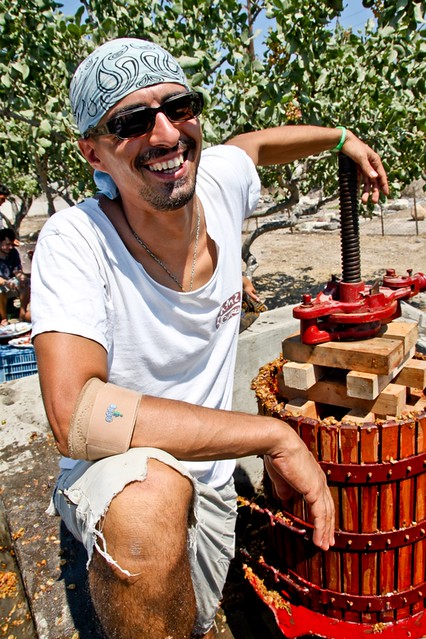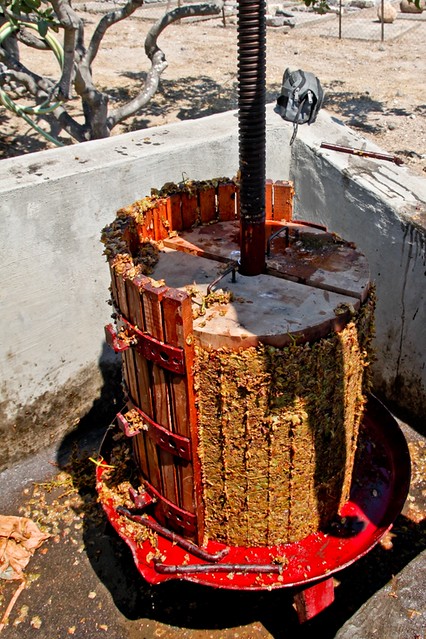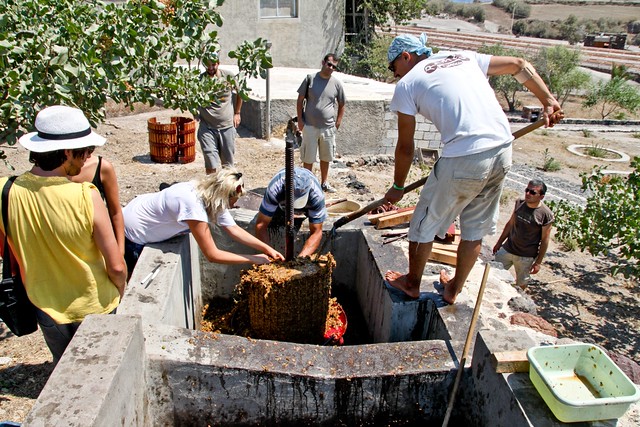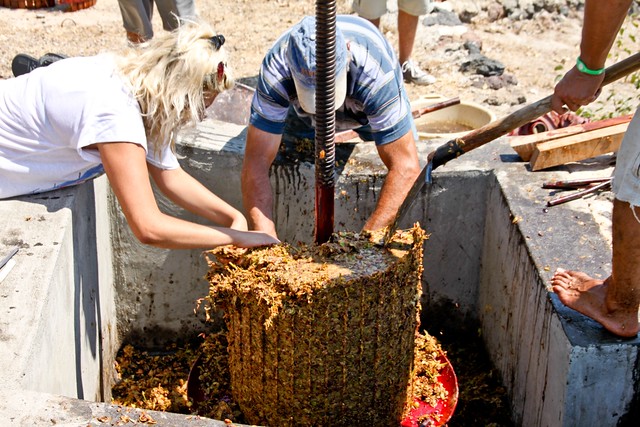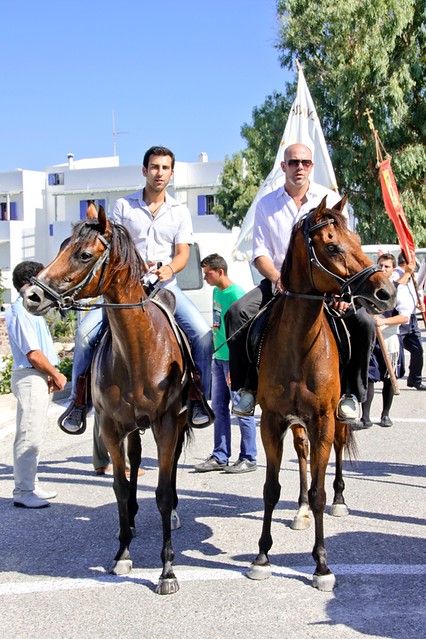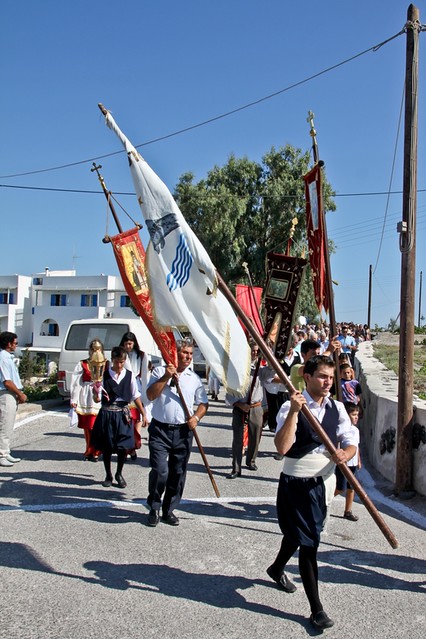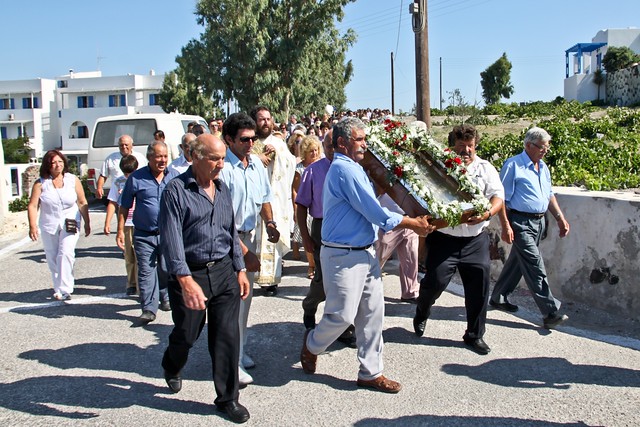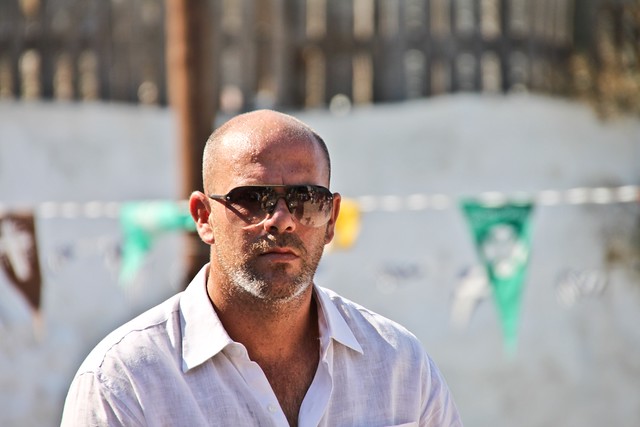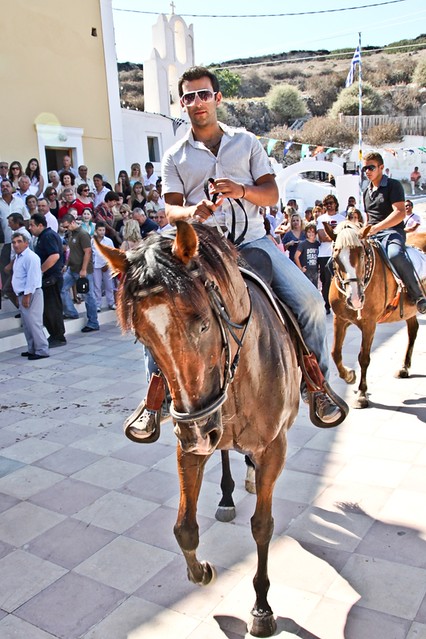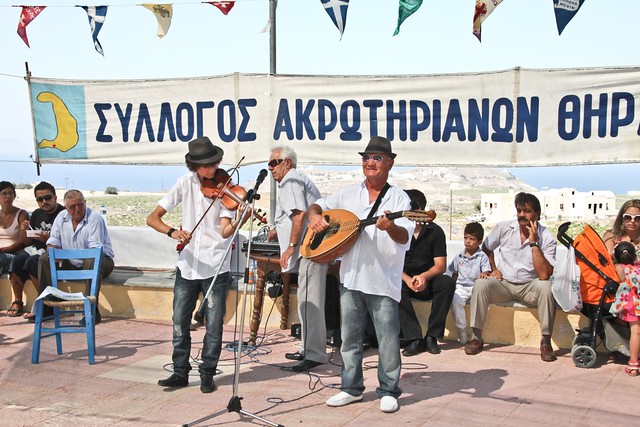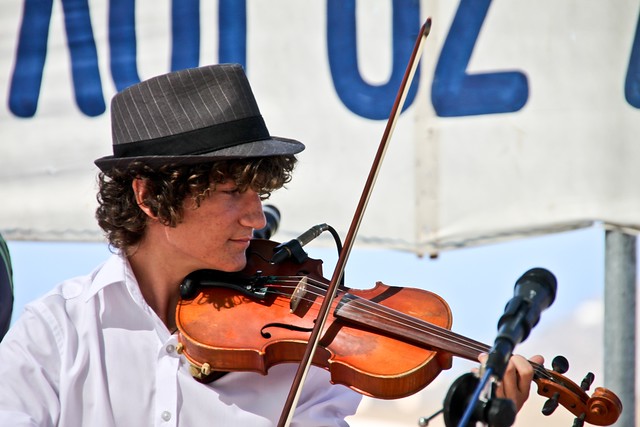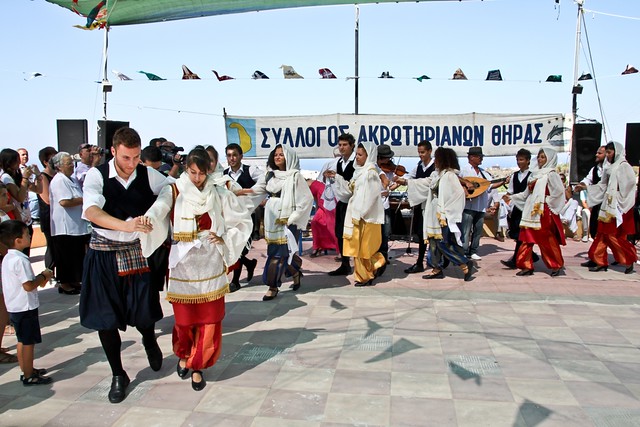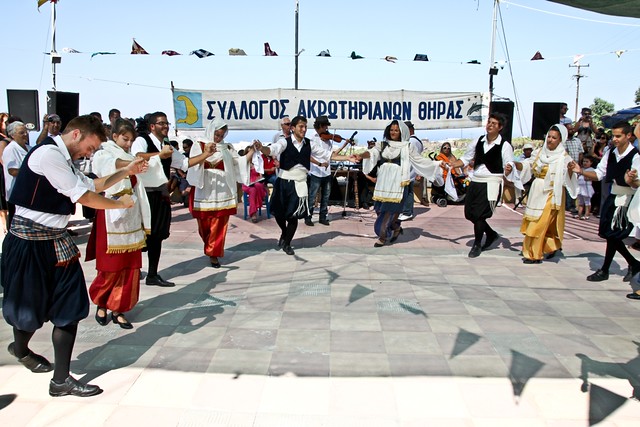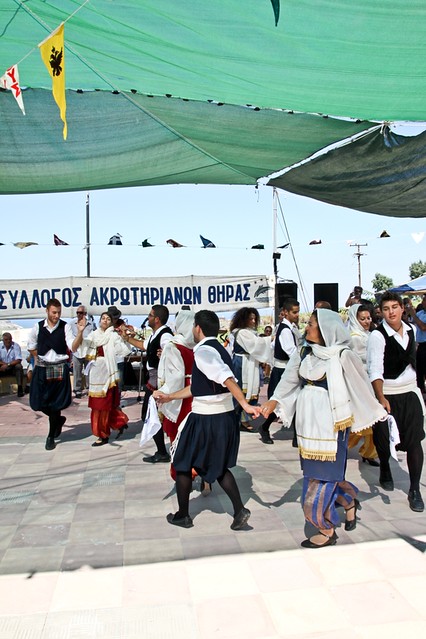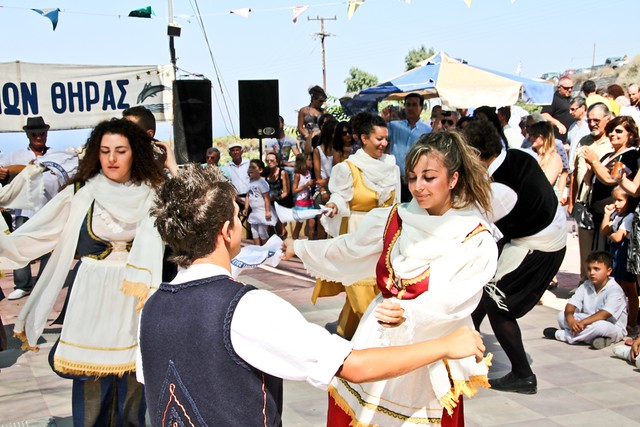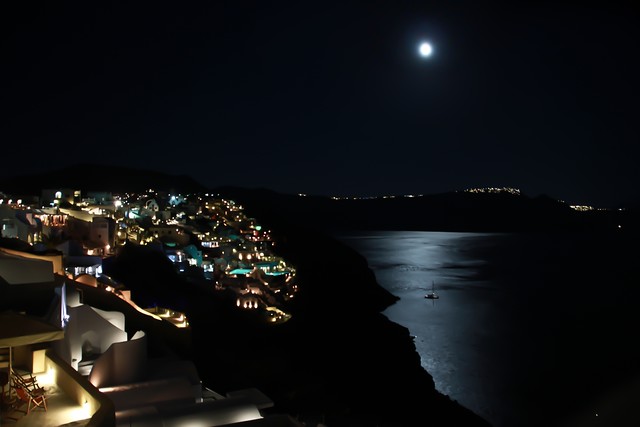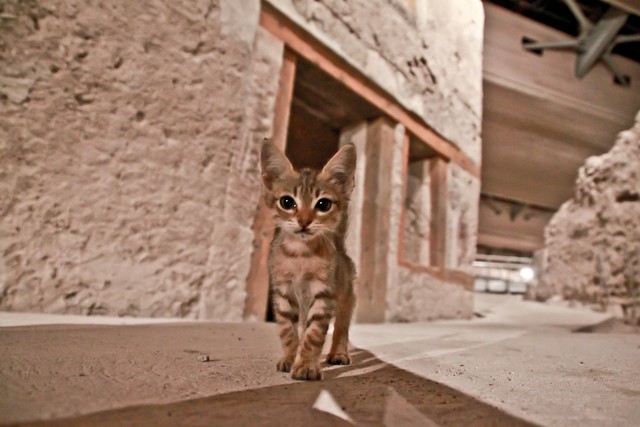Η "Πότνια θηρών" είναι τοιχογραφία που ανακαλύφθηκε στον οικισμό του Ακρωτηρίου Θήρας και κοσμούσε τον βόρειο τοίχο του δωματίου 3Α του πρώτου ορόφου του κτιρίου που αποκαλείται από τους αρχαιολόγους "Ξεστή 3". Αποτελεί θεματική ενότητα με την τοιχογραφία με τις "Κροκοσυλλέκτριες" που βρισκόταν στο ίδιο δωμάτιο. Η Ξεστή 3 είναι το μόνο - μέχρι τώρα - αδιαμφισβήτητο δημόσιο ιερό του οικισμού. Στον βόρειο τοίχο του δωματίου υπάρχει παράθυρο. Στο τμήμα του τοίχου στα αριστερά του παραθύρου (δυτικό τμήμα) βρίσκεται η Πότνια θηρών (δέσποινα των ζώων), η οποία, καθισμένη σε βαθμιδωτό θρόνο, δέχεται την προσφορά των κρόκων από κροκοσυλλέκτρια που αδειάζει τα καλάθι της σε ένα πανέρι που βρίσκεται μπροστά της. Δίπλα στην Πότνια θηρών βρίσκεται ένας γρύπας, ενώ μπροστά της ένας κυανοπίθηκος. Η θεά έχει εντυπωσιακή κόμμωση με χρυσό διάδημα, ενώ στα μαλλιά της υπάρχει και κορδόνι με χρυσούς κόμπους. Στο λαιμό της φοράει ένα περιδέραιο από χάντρες με σχήμα πάπιας και ένα περιδέραιο με λιβελούλες, σε διάφορους χρωματισμούς και τα δύο, ενώ στο αυτί έχει χρυσό σκουλαρίκι. Το φόντο της τοιχογραφίας είναι ένα λιβάδι με κρόκους. Η Πότνια θηρών φορά πτυχωτή Μινωική φούστα και πουκάμισο το οποίο αφήνει ακάλυπτο το στήθος.
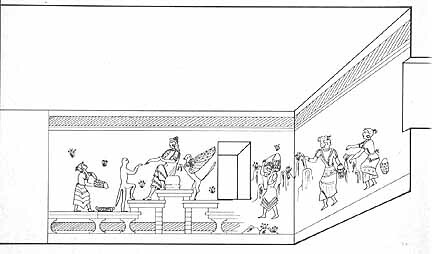
Στο τμήμα της τοιχογραφικής σύνθεσης στα δεξιά του παραθύρου (ανατολικό τμήμα) απεικονίζεται μία κροκοσυλλέκτρια, η οποία μεταφέρει τον κρόκο σε καλάθι στον ώμο της, προφανώς για να πάει να το προσφέρει στην Πότνια θηρών.
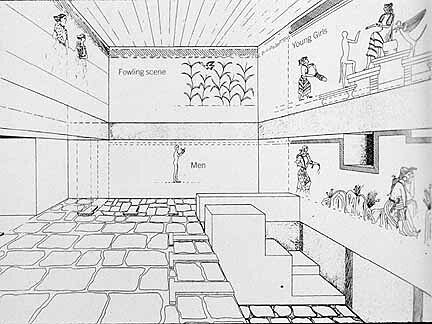
Η συνολική θεματική ενότητα, δηλαδή η τοιχογραφία με τις Κροκοσυλλέκτριες και η τοιχογραφία με την Πότνια θηρών, περιλαμβάνει μία θεότητα, μία ιέρεια και τρεις κροκοσυλλέκτριες.
Από την Μινωική στην Μυκηναϊκή εποχή
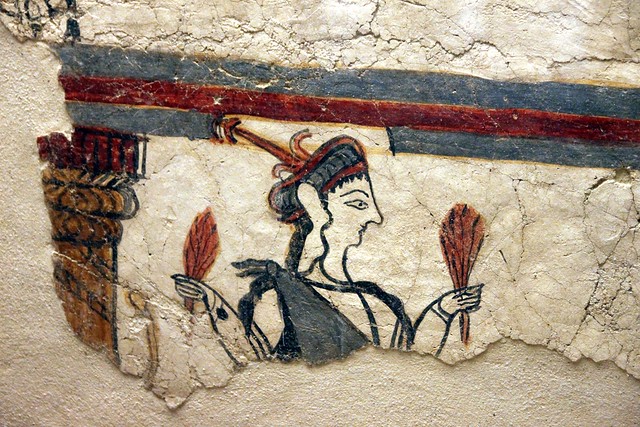

Στο τμήμα της τοιχογραφικής σύνθεσης στα δεξιά του παραθύρου (ανατολικό τμήμα) απεικονίζεται μία κροκοσυλλέκτρια, η οποία μεταφέρει τον κρόκο σε καλάθι στον ώμο της, προφανώς για να πάει να το προσφέρει στην Πότνια θηρών.

Η συνολική θεματική ενότητα, δηλαδή η τοιχογραφία με τις Κροκοσυλλέκτριες και η τοιχογραφία με την Πότνια θηρών, περιλαμβάνει μία θεότητα, μία ιέρεια και τρεις κροκοσυλλέκτριες.
Από την Μινωική στην Μυκηναϊκή εποχή

Η θρησκεία της Πότνιας θηρών βρήκε πρόσφορο έδαφος στην ηπειρωτική Ελλάδα της Μυκηναϊκής εποχής. Η λεπτομέρεια της φωτογραφίας είναι από το μεγαλύτερο κομμάτι μυκηναϊκής τοιχογραφίας που βρέθηκε στη θέση του. Παρότι η ποιότητα του είναι ικανοποιητική, υπάρχουν δείγματα βιασύνης στη ζωγραφική.
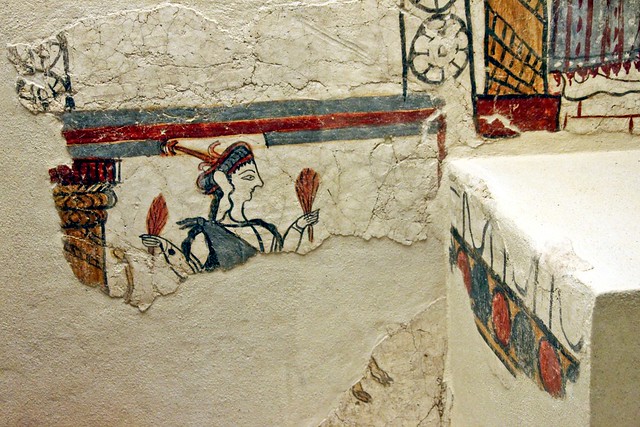
Στην λεπτομέρεια αυτή παριστάνεται ένα δωμάτιο με δύο κίονες μεταξύ των οποίων στέκεται μια γυναικεία μορφή που κρατά στα υψωμένα χέρια της δεμάτια σίτου. Η κίτρινη ουρά και τα μπροστινά πόδια είναι ό,τι απέμεινε από ένα γρύπα που την συνόδευε. Στα δεξιά υπάρχει ένας βωμός που πιθανώς ήταν αρχικά ολόκληρος επιχρισμένος και διακοσμημένος.

Στο ανώτερο επίπεδο την αριστερή πλευρά καταλαμβάνει το πλαίσιο μιας θύρας που κοσμούν ρόδακες, ενώ στα δεξιά μια γυναικεία μορφή με μανδύα που κρατά ξίφος αντικρίζει μια άλλη που κρατά δόρυ. Ανάμεσα τους αιωρούνται δύο αντρικές γυμνές μικρογραφικές μορφές. Όλες οι μορφές έχουν ενταχθεί στο πλαίσιο ενός δωματίου με δάπεδο από πλακάκια ή τούβλα και δύο κίονες με ελικοειδή διακόσμηση, που στηρίζουν την οροφή. Το ένδυμα της αριστερής μορφής είναι μυκηναϊκού τύπου, ενώ της δεξιάς είναι το ίδιο που φοράει η Πότνια θηρών του Ακρωτηρίου, δηλαδή πτυχωτή Μινωική φούστα και πουκάμισο το οποίο αφήνει ακάλυπτο το στήθος.
Στα μάτια μου η τοιχογραφία αυτή παρουσιάζει μια μετάβαση εξουσίας. Η εξουσία, από την Μινωϊκή Ελλάδα περνάει στην Μυκηναϊκή Ελλάδα. Το πιο σημαντικό, όμως, κατά την γνώμη μου είναι ότι αυτή η τοιχογραφία εκφράζει και μια συνέχεια. Μια συνέχεια στον πολιτισμό του Ελλαδικού χώρου...
Η ονομασία "Πότνια θηρών" προέρχεται από τον Όμηρο και είναι τίτλος που δίνει ο ποιητής στην θεά Άρτεμη: "τὸν δὲ κασιγνήτη μάλα νείκεσε πότνια θηρῶνἌρτεμις ἀγροτέρη, καὶ ὀνείδειον φάτο μῦθον·φεύγεις δὴ ἑκάεργε, Ποσειδάωνι δὲ νίκηνπᾶσαν ἐπέτρεψας, μέλεον δέ οἱ εὖχος ἔδωκας·νηπύτιε τί νυ τόξον ἔχεις ἀνεμώλιον αὔτως;" Ραψωδία Φ, στίχος 470.
Πηγές / Sources:
Μπουλώτης Χρ.: "Πτυχές θρησκευτικής έκφρασης στο Ακρωτήρι". Περιοδικό ΑΛΣ, Εταιρεία Στήριξης Σπουδών Προϊστορικής Θήρας, Τεύχος 3, Αθήνα 2005
Christos Doumas, "The Wall-paintings of Thera" ISBN-10: 9602202742
Sign in the Archaeological Museum of Mycenae
Representation of Xeste 3 by the University of Oklahoma
[ENG] "Potnia Theron" or "Mistress of the Beasts" is a fresco which existed on the north wall of the room 3A in the first floor of the building "Xeste 3" of the Prehistoric settlement of Akrotiri. [1][2][3] "At the center of the representation is a majestic female figure seated on a stepped structure. Of her elaborate and precious parure, two necklaces are particularly impressive: the beads of one are in the form of ducks and of the other in the form of dragonflies. The outline of her flowing luxuriant locks is followed by a serpentine band with a row of dots along its outer side. The figure is flanked in the left by a blue monkey and the right by a griffin. Behind the monkey is another female figure, slightly bent over as she empties the crocuses from her basket into a large pannier on the ground. Although the lower part of the griffin is not well preserved, its pose is clear. It too is presented as if climbing up to the seated figure, its front legs placed on the stepped structure. Behind the griffin, and beyond the window that existed there, there is another crocus-gatherer, carrying a basket on her left shoulder and supporting it below with the fingers of her left hand. She steadies it by holding the rope tied to the handle high up above her head with her right hand" [Source]. From Minoan to Mycenaean Greece: [4][5][6] The mural is the largest piece of Mycenaean wall painting preserved in situ. Although competent, it shows signs of haste. It and the altar in front of it should be viewed as a single unit representing an architectural setting with three female figures on two different levels. The upper level includes on the left a blank doorway framed with rosettes and to the right, a cloaked female figure holding a sword and facing another woman holding a staff. Between them are two small naked male figurines in mid-air. All these figures are framed in a room with two spiral columns, a brick of tile floor and a ceiling supported by the columns. The lower level includes on the left a room with two columns, within which is a standing female with her hands raised, holding sheaves of wheat. The yellow tail and forepaws are all that remains of a griffin accompanying her. On the right, is an altar which was probably once completely plastered and painted all over. The decoration of "horns" and the painted ends of beams on the side suggests that it represent the exterior of a building. Two female figures are dressed in the kind of clothes worn by Mycenaean women, while the third one wears exactly the Potnia Theron of Akrotiri wears. In my eyes the mural presents a transition of power. The power from the Minoan Greece passes to the Mycenaean Greece. More importantly, though, in my opinion is that this mural represents a continuity. A continuity of the culture in the Greek territory... The first time the name "Potnia Theron" appears is in Iliad xxi.470, when Homer talks about Goddess Artemis.

Στην λεπτομέρεια αυτή παριστάνεται ένα δωμάτιο με δύο κίονες μεταξύ των οποίων στέκεται μια γυναικεία μορφή που κρατά στα υψωμένα χέρια της δεμάτια σίτου. Η κίτρινη ουρά και τα μπροστινά πόδια είναι ό,τι απέμεινε από ένα γρύπα που την συνόδευε. Στα δεξιά υπάρχει ένας βωμός που πιθανώς ήταν αρχικά ολόκληρος επιχρισμένος και διακοσμημένος.

Στο ανώτερο επίπεδο την αριστερή πλευρά καταλαμβάνει το πλαίσιο μιας θύρας που κοσμούν ρόδακες, ενώ στα δεξιά μια γυναικεία μορφή με μανδύα που κρατά ξίφος αντικρίζει μια άλλη που κρατά δόρυ. Ανάμεσα τους αιωρούνται δύο αντρικές γυμνές μικρογραφικές μορφές. Όλες οι μορφές έχουν ενταχθεί στο πλαίσιο ενός δωματίου με δάπεδο από πλακάκια ή τούβλα και δύο κίονες με ελικοειδή διακόσμηση, που στηρίζουν την οροφή. Το ένδυμα της αριστερής μορφής είναι μυκηναϊκού τύπου, ενώ της δεξιάς είναι το ίδιο που φοράει η Πότνια θηρών του Ακρωτηρίου, δηλαδή πτυχωτή Μινωική φούστα και πουκάμισο το οποίο αφήνει ακάλυπτο το στήθος.
Στα μάτια μου η τοιχογραφία αυτή παρουσιάζει μια μετάβαση εξουσίας. Η εξουσία, από την Μινωϊκή Ελλάδα περνάει στην Μυκηναϊκή Ελλάδα. Το πιο σημαντικό, όμως, κατά την γνώμη μου είναι ότι αυτή η τοιχογραφία εκφράζει και μια συνέχεια. Μια συνέχεια στον πολιτισμό του Ελλαδικού χώρου...
Η ονομασία "Πότνια θηρών" προέρχεται από τον Όμηρο και είναι τίτλος που δίνει ο ποιητής στην θεά Άρτεμη: "τὸν δὲ κασιγνήτη μάλα νείκεσε πότνια θηρῶνἌρτεμις ἀγροτέρη, καὶ ὀνείδειον φάτο μῦθον·φεύγεις δὴ ἑκάεργε, Ποσειδάωνι δὲ νίκηνπᾶσαν ἐπέτρεψας, μέλεον δέ οἱ εὖχος ἔδωκας·νηπύτιε τί νυ τόξον ἔχεις ἀνεμώλιον αὔτως;" Ραψωδία Φ, στίχος 470.
Πηγές / Sources:
Μπουλώτης Χρ.: "Πτυχές θρησκευτικής έκφρασης στο Ακρωτήρι". Περιοδικό ΑΛΣ, Εταιρεία Στήριξης Σπουδών Προϊστορικής Θήρας, Τεύχος 3, Αθήνα 2005
Christos Doumas, "The Wall-paintings of Thera" ISBN-10: 9602202742
Sign in the Archaeological Museum of Mycenae
Representation of Xeste 3 by the University of Oklahoma
[ENG] "Potnia Theron" or "Mistress of the Beasts" is a fresco which existed on the north wall of the room 3A in the first floor of the building "Xeste 3" of the Prehistoric settlement of Akrotiri. [1][2][3] "At the center of the representation is a majestic female figure seated on a stepped structure. Of her elaborate and precious parure, two necklaces are particularly impressive: the beads of one are in the form of ducks and of the other in the form of dragonflies. The outline of her flowing luxuriant locks is followed by a serpentine band with a row of dots along its outer side. The figure is flanked in the left by a blue monkey and the right by a griffin. Behind the monkey is another female figure, slightly bent over as she empties the crocuses from her basket into a large pannier on the ground. Although the lower part of the griffin is not well preserved, its pose is clear. It too is presented as if climbing up to the seated figure, its front legs placed on the stepped structure. Behind the griffin, and beyond the window that existed there, there is another crocus-gatherer, carrying a basket on her left shoulder and supporting it below with the fingers of her left hand. She steadies it by holding the rope tied to the handle high up above her head with her right hand" [Source]. From Minoan to Mycenaean Greece: [4][5][6] The mural is the largest piece of Mycenaean wall painting preserved in situ. Although competent, it shows signs of haste. It and the altar in front of it should be viewed as a single unit representing an architectural setting with three female figures on two different levels. The upper level includes on the left a blank doorway framed with rosettes and to the right, a cloaked female figure holding a sword and facing another woman holding a staff. Between them are two small naked male figurines in mid-air. All these figures are framed in a room with two spiral columns, a brick of tile floor and a ceiling supported by the columns. The lower level includes on the left a room with two columns, within which is a standing female with her hands raised, holding sheaves of wheat. The yellow tail and forepaws are all that remains of a griffin accompanying her. On the right, is an altar which was probably once completely plastered and painted all over. The decoration of "horns" and the painted ends of beams on the side suggests that it represent the exterior of a building. Two female figures are dressed in the kind of clothes worn by Mycenaean women, while the third one wears exactly the Potnia Theron of Akrotiri wears. In my eyes the mural presents a transition of power. The power from the Minoan Greece passes to the Mycenaean Greece. More importantly, though, in my opinion is that this mural represents a continuity. A continuity of the culture in the Greek territory... The first time the name "Potnia Theron" appears is in Iliad xxi.470, when Homer talks about Goddess Artemis.



